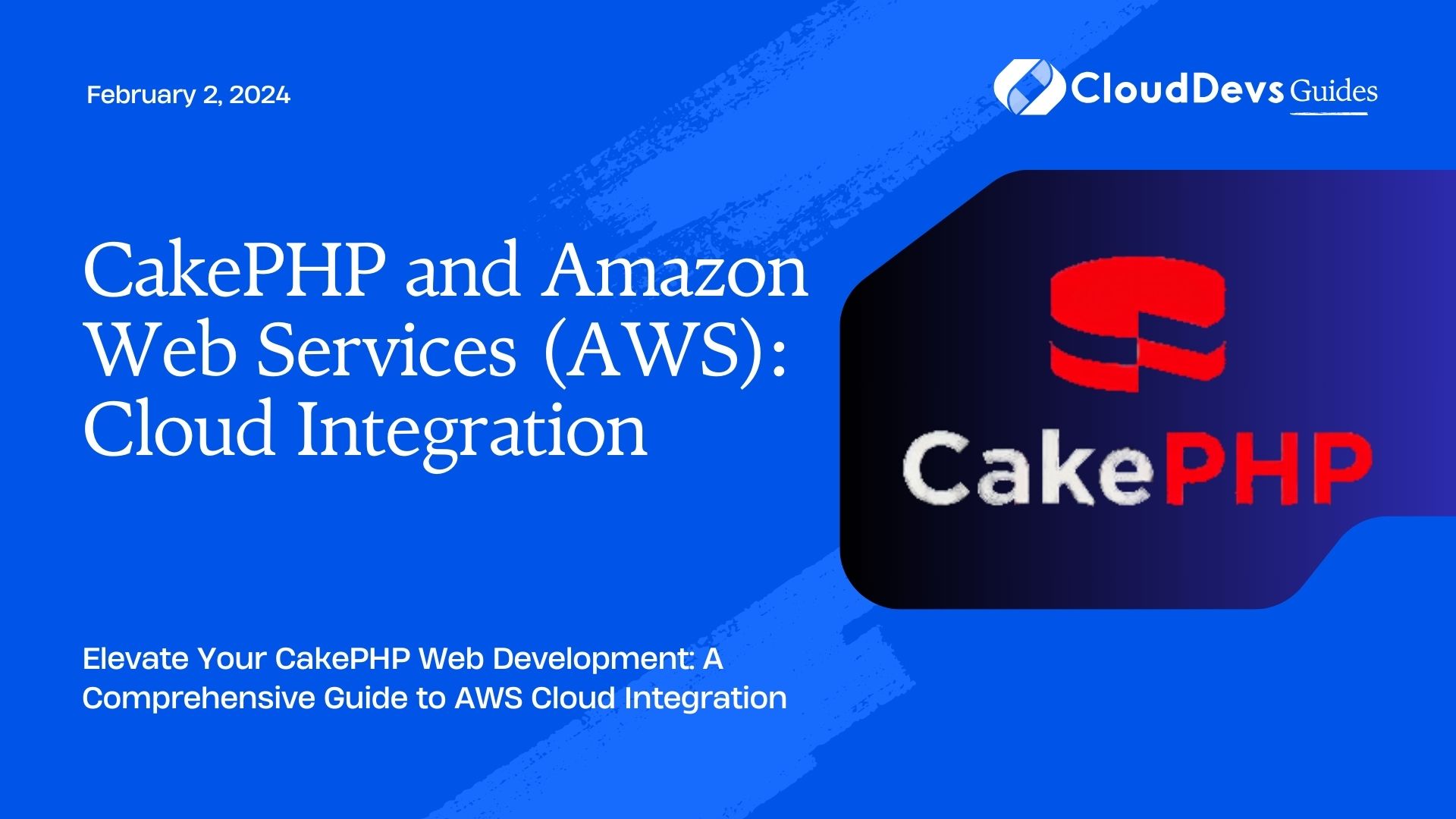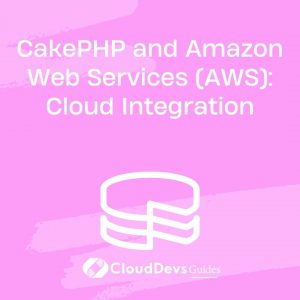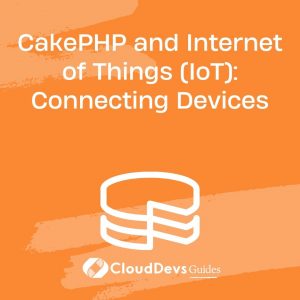CakePHP and Amazon Web Services (AWS): Cloud Integration
In today’s fast-paced digital world, building web applications that can scale and perform reliably is crucial. CakePHP, a popular PHP framework known for its elegance and simplicity, offers an excellent foundation for web development projects. But what happens when you need to scale your CakePHP application, ensure high availability, or leverage cloud-based resources efficiently? That’s where Amazon Web Services (AWS) comes into play.
Table of Contents
This blog will guide you through the process of integrating CakePHP with AWS, allowing you to harness the power of the cloud to enhance your web application’s performance, reliability, and scalability. We’ll cover essential topics, provide code samples, and explore best practices to help you embark on a seamless CakePHP and AWS integration journey.
1. Why CakePHP and AWS Integration Matters
Before delving into the technical aspects, let’s briefly discuss why integrating CakePHP with AWS is essential for modern web development:
1.1. Scalability
AWS offers a wide array of services designed for scalability. Whether your CakePHP application experiences sudden traffic spikes or gradual growth, AWS can dynamically allocate resources to meet the demand, ensuring optimal performance without unnecessary costs.
1.2. High Availability
AWS provides global data centers and a robust infrastructure, allowing you to create highly available architectures. By distributing your CakePHP application across multiple availability zones, you can minimize downtime and enhance reliability.
1.3. Cost Efficiency
With AWS, you only pay for the resources you use. This pay-as-you-go model can significantly reduce infrastructure costs compared to traditional hosting solutions, making it an attractive option for startups and enterprises alike.
1.4. Flexibility
AWS offers a vast ecosystem of services, from databases to machine learning, IoT, and more. Integrating CakePHP with AWS opens up opportunities to leverage these services and enhance your application’s functionality.
2. Getting Started with CakePHP
Before we jump into AWS integration, let’s ensure you have a basic understanding of CakePHP. If you’re already familiar with CakePHP, feel free to skip ahead.
2.1. Installation
To get started with CakePHP, you can use Composer, a popular PHP package manager:
bash composer create-project --prefer-dist cakephp/app myapp
This command creates a new CakePHP project in a directory named myapp. You can replace myapp with your preferred project name.
2.2. MVC Architecture
CakePHP follows the Model-View-Controller (MVC) architectural pattern, which separates your application’s logic into three main components:
- Model: Represents the data and database interactions.
- View: Handles the presentation and user interface.
- Controller: Manages the application’s flow and communicates between the Model and View.
2.3. Routing
CakePHP’s powerful routing system allows you to define clean and SEO-friendly URLs. Routes are typically defined in the config/routes.php file.
php
// Example route definition
Router::scope('/', function (RouteBuilder $routes) {
$routes->connect('/articles/:slug', ['controller' => 'Articles', 'action' => 'view'])
->setPatterns(['slug' => '[a-z0-9\-]+'])
->setPass(['slug']);
// Add more routes as needed
});
3. Setting Up an AWS Account
Before we proceed with the integration, you’ll need an AWS account. If you don’t have one, follow these steps to get started:
3.1. Sign Up for an AWS Account
Go to the AWS website, click on “Create an AWS Account,” and follow the on-screen instructions. You’ll need to provide payment information, but many AWS services offer a free tier with limited usage, so you can explore AWS without incurring charges initially.
3.2. Access AWS Management Console
Once you have an account, you can access the AWS Management Console, which is the web-based interface for managing your AWS resources. This is where you’ll configure and manage AWS services for your CakePHP application.
3.3. Create an IAM User
To ensure security best practices, it’s essential to create an Identity and Access Management (IAM) user with the appropriate permissions for your CakePHP and AWS integration. Avoid using your root AWS account for day-to-day tasks.
Here’s how you can create an IAM user:
- Sign in to the AWS Management Console.
- Navigate to the IAM dashboard.
- Click on “Users” in the left navigation pane.
- Click “Add user.”
- Follow the steps to configure the user and attach permissions policies.
Make sure to save the user’s access key and secret access key securely, as you’ll need them later when interacting with AWS programmatically.
4. Integrating CakePHP with AWS S3
Now that you have your CakePHP project set up and an AWS account ready, let’s dive into one of the most common AWS integrations: Amazon S3 for file storage. Amazon S3 is a highly scalable and reliable object storage service.
4.1. Install the AWS SDK for PHP
To interact with AWS services like S3, you’ll need to install the AWS SDK for PHP. You can install it using Composer:
bash composer require aws/aws-sdk-php
This command adds the AWS SDK for PHP as a dependency to your CakePHP project.
4.2. Configure AWS Credentials
To interact with AWS services, you must configure your AWS credentials. Open your CakePHP project’s config/app.php file and add your AWS access key and secret access key to the Datasources section:
php
'Datasources' => [
'default' => [
// Other configuration settings
'S3' => [
'key' => 'YOUR_AWS_ACCESS_KEY',
'secret' => 'YOUR_AWS_SECRET_ACCESS_KEY',
'region' => 'us-east-1', // Change to your desired AWS region
'version' => 'latest',
],
],
],
4.3. Create a Helper for Amazon S3
To make working with Amazon S3 in your CakePHP application more straightforward, you can create a custom helper. Helpers in CakePHP are used to encapsulate functionality that can be reused across different views.
Create a new helper named S3Helper.php in your src/View/Helper directory:
php
// src/View/Helper/S3Helper.php
namespace App\View\Helper;
use Cake\View\Helper;
class S3Helper extends Helper
{
protected $_defaultConfig = [
'bucket' => 'your-s3-bucket-name',
];
public function getObjectUrl($key)
{
$client = new \Aws\S3\S3Client([
'version' => 'latest',
'region' => 'us-east-1', // Change to your desired AWS region
'credentials' => [
'key' => $this->getConfig('key'),
'secret' => $this->getConfig('secret'),
],
]);
$bucket = $this->getConfig('bucket');
$url = $client->getObjectUrl($bucket, $key);
return $url;
}
}
This helper allows you to generate URLs for objects stored in your Amazon S3 bucket.
4.4. Using the S3Helper
Now that you have created the S3Helper, you can use it in your CakePHP views to generate Amazon S3 URLs for your objects. For example, if you want to display an image stored in your S3 bucket, you can do the following:
php
<?= $this->S3->getObjectUrl('image.jpg') ?>
This will generate the URL for the image.jpg object in your S3 bucket.
5. Deploying CakePHP on AWS Elastic Beanstalk
While integrating CakePHP with Amazon S3 is a significant step towards leveraging AWS services, deploying your application on AWS Elastic Beanstalk offers even more benefits. Elastic Beanstalk is a Platform as a Service (PaaS) offering that simplifies application deployment and management.
Here’s how to deploy your CakePHP application on AWS Elastic Beanstalk:
5.1. Configure Your CakePHP Application
Before deploying to Elastic Beanstalk, ensure that your CakePHP application is ready for production. Update the configuration files, including config/app.php, to use the appropriate production settings.
5.2. Create a ZIP Archive
Create a ZIP archive of your CakePHP application’s files, excluding unnecessary development files and directories. This archive will be uploaded to Elastic Beanstalk.
bash zip -r myapp.zip *
5.3. Sign in to AWS Elastic Beanstalk
- Sign in to the AWS Management Console.
- Navigate to the Elastic Beanstalk dashboard.
5.4. Create an Elastic Beanstalk Environment
Click on “Create a new environment” and choose “Web server environment.” Follow the wizard to configure your environment:
- Platform: Select the appropriate PHP platform.
- Upload Your Code: Upload the ZIP archive created earlier.
- Environment Information: Set your environment name and description.
- Additional Resources: Configure the desired instance type, auto-scaling settings, and database connections.
- Environment Tags: Add tags if necessary.
- Permissions: Configure the necessary permissions for your application.
5.5. Deploy Your CakePHP Application
Once the environment is created, Elastic Beanstalk will automatically deploy your CakePHP application. You can monitor the deployment progress from the Elastic Beanstalk dashboard.
5.6. Access Your CakePHP Application
Once the deployment is complete, you can access your CakePHP application using the provided Elastic Beanstalk URL. You can also configure a custom domain if needed.
6. Leveraging AWS RDS for Database
Integrating CakePHP with AWS extends beyond just storage. AWS provides managed database services like Amazon RDS (Relational Database Service), which can simplify database management, improve scalability, and enhance performance.
Here’s how you can integrate CakePHP with Amazon RDS:
6.1. Create an Amazon RDS Instance
- Sign in to the AWS Management Console.
- Navigate to the Amazon RDS dashboard.
- Click “Create database” and follow the wizard to configure your RDS instance. You can choose from various database engines, including MySQL, PostgreSQL, and SQL Server.
6.2. Update CakePHP Configuration
In your CakePHP project’s config/app.php file, update the database configuration to connect to your Amazon RDS instance:
php
'Datasources' => [
'default' => [
// Other configuration settings
'host' => 'your-rds-endpoint',
'username' => 'your-rds-username',
'password' => 'your-rds-password',
'database' => 'your-rds-database',
'port' => '3306', // Adjust based on your RDS configuration
],
],
6.3. Migrate and Seed the Database
If you’re migrating an existing CakePHP application to Amazon RDS, you’ll need to migrate and seed the database to the new RDS instance. Use CakePHP’s built-in migration and seed features for this purpose.
bash bin/cake migrations migrate bin/cake migrations seed
6.4. Monitor and Optimize
With Amazon RDS, you can easily monitor database performance and make optimizations as needed using AWS’s built-in tools and services.
7. Implementing AWS Lambda for Serverless Functionality
AWS Lambda allows you to run code without provisioning or managing servers. You can use Lambda to execute serverless functions for various tasks, such as processing data, running background jobs, or integrating with third-party services.
Here’s how to integrate AWS Lambda with your CakePHP application:
7.1. Create a Lambda Function
- Sign in to the AWS Management Console.
- Navigate to the Lambda dashboard.
- Click “Create function” and follow the wizard to create your Lambda function. You can write your function code in supported languages like Node.js, Python, or PHP.
7.2. Configure Triggers
Lambda functions can be triggered by various AWS services, such as Amazon S3, API Gateway, or AWS Step Functions. Configure the necessary triggers based on your CakePHP application’s requirements.
7.3. Integrate Lambda with CakePHP
To invoke your Lambda functions from your CakePHP application, you can use the AWS SDK for PHP. Here’s an example of invoking a Lambda function from a CakePHP controller:
php
// In your CakePHP controller
use Aws\Lambda\LambdaClient;
$lambdaClient = new LambdaClient([
'version' => 'latest',
'region' => 'us-east-1', // Change to your AWS region
'credentials' => [
'key' => 'YOUR_AWS_ACCESS_KEY',
'secret' => 'YOUR_AWS_SECRET_ACCESS_KEY',
],
]);
$result = $lambdaClient->invoke([
'FunctionName' => 'your-lambda-function-name',
'Payload' => json_encode(['key' => 'value']), // Customize the payload as needed
]);
$response = json_decode($result['Payload']->getContents(), true);
// Handle the Lambda function's response in your CakePHP application
Conclusion
Integrating CakePHP with Amazon Web Services (AWS) opens up a world of possibilities for building scalable, reliable, and efficient web applications. From leveraging Amazon S3 for file storage to deploying on AWS Elastic Beanstalk, using Amazon RDS for databases, and implementing AWS Lambda for serverless functionality, AWS offers a comprehensive suite of services to enhance your CakePHP projects.
As you embark on your CakePHP and AWS integration journey, remember to follow best practices for security, cost optimization, and performance tuning. With the right approach, you can create web applications that not only meet your current needs but also scale seamlessly as your user base grows. Start exploring the power of CakePHP and AWS today and take your web development projects to the next level.
Table of Contents








